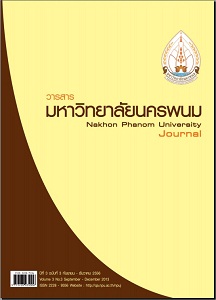การเปรียบเทียบผลสัมฤทธิ์ทางการเรียนเรื่อง วัฒนธรรมน่ารู้และความฉลาดทางอารมณ์ ของนักเรียนชั้นประถมศึกษาปีที่ 2 ระหว่างการจัดการเรียนรู้ตามแนวคิด โดยใช้ สมองเป็นฐาน (BBL) กับการเรียนรู้ด้วยกลุ่มร่วมมือแบบ jigsaw II
Main Article Content
Abstract
การวิจัยครั้งนี้มีวัตถุประสงค์เพื่อ 1) หาประสิทธิภาพของแผนการจัดกิจกรรมการเรียนรู้ เรื่อง วัฒนธรรมน่ารู้ชั้นประถมศึกษา ปีที่ 2 ที่ได้รับการจัดกิจกรรมตามแนวคิดโดยใช้สมองเป็นฐานกับกลุ่มร่วมมือแบบ Jigsaw II ตามเกณฑ์ 80/80 2) หาดัชนีประสิทธิผล ของแผนการจัดกิจกรรมการเรียนรู้ทั้ง 2 วิธี และ 3) เปรียบเทียบผลสัมฤทธิ์ทางการเรียน และความฉลาดทางอารมณ์ของนักเรียน ชั้นประถมศึกษาปีที่ 2 ระหว่างการจัดกิจกรรมการเรียนรู้ทั้ง 2 วิธี กลุ่มตัวอย่างที่ใช้ ได้แก่ นักเรียน ชั้นประถมศึกษาปีที่ 2 โรงเรียน บ้านห้วยพระและโรงเรียนบ้านดอนแดง สำนักงานเขตพื้นที่การประถมศึกษานครพนมเขต 2 ภาคเรียนที่ 1 ปีการศึกษา 2554 จำนวน 2 ห้อง รวม 40 คน ซึ่งได้มาโดยการสุ่มแบบกลุ่ม จำแนกเป็นนักเรียนชั้นประถมศึกษาปีที่ 2 โรงเรียนบ้านห้วยพระ จำนวน 20 คน เรียนด้วยการจัดการเรียนรู้ตามแนวคิดโดยใช้สมองเป็นฐาน และนักเรียนชั้นประถมศึกษาปีที่ 2 โรงเรียนบ้านดอนแดง จำนวน 20 คน เรียนด้วยกลุ่มร่วมมือแบบ Jigsaw II ซึ่งได้มาโดยการสุ่มแบบกลุ่ม เครื่องมือที่ใช้ ได้แก่ 1) แผนการจัดการเรียนรู้ตามแนวคิดโดยใช้สมอง เป็นฐานและแผนการจัดการเรียนรู้ด้วยกลุ่มร่วมมือแบบ Jigsaw II อย่างละ 13 แผน 2) แบบทดสอบผลสัมฤทธิ์ทางการเรียน ชนิดปรนัย จำนวน 30 ข้อ มีค่าความยากตั้งแต่ 0.40-0.69 ค่าอำนาจจำแนกตั้งแต่ 0.26–0.83 และค่าความเชื่อมั่นทั้งฉบับเท่ากับ 0.79 และ 3) แบบวัดความฉลาดทางอารมณ์เป็นแบบมาตราส่วนประมาณค่า จำนวน 20 ข้อ มีค่าอำนาจจำแนกรายข้อตั้งแต่ 0.34-0.64 และค่าความเชื่อมั่นเท่ากับ 0.84 สถิติที่ใช้ในการวิเคราะห์ข้อมูลได้แก่ ร้อยละ ค่าเฉลี่ยส่วนเบี่ยงเบนมาตรฐาน และทดสอบสมมติฐาน โดยใช้ t-test (Independent Samples) ผลการวิจัยพบว่า 1) แผนการจัดการเรียนรู้ตามแนวคิดโดยใช้สมองเป็นฐานและแผน การจัดการเรียนรู้แบบ Jigsaw II มีประสิทธิภาพเท่ากับ 88.69/81.83 และ 90.40/80.17 ตามลำดับ 2) ดัชนีประสิทธิผลของแผน การจัดการเรียนรู้ทั้ง 2 วิธีมีค่าเท่ากับ 0.4783 และ 0.5250 ตามลำดับ 3) นักเรียนชั้นประถมศึกษาปีที่ 2 กลุ่มที่เรียนด้วยกิจกรรม การเรียนรู้ตามแนวคิดโดยใช้สมองเป็นฐานมีคะแนนเฉลี่ยผลสัมฤทธิ์ทางการเรียนสูงกว่ากลุ่มที่เรียนด้วยการจัดกิจกรรมการเรียนรู้ด้วย กลุ่มร่วมมือแบบ Jigsaw II อย่างมีนัยสำคัญทางสถิติที่ระดับ .05 และนักเรียนที่เรียนโดยการจัดกิจกรรมการเรียนรู้ด้วยกลุ่มร่วมมือ แบบ Jigsaw II มีคะแนนเฉลี่ยความฉลาดทางอารมณ์สูงกว่ากลุ่มที่เรียนด้วยการจัดกิจกรรมการเรียนรู้ตามแนวคิดโดยใช้สมองเป็นฐาน อย่างมีนัยสำคัญทางสถิติที่ระดับ .05
The purposes of this study were : 1) to investigate efficiency of learning activity management plan on ‘Interesting Culture’ for Prathom Suksa 2 students who were given the activities using the brain-based learning approach versus the technique jigsaw II cooperative learning approach with the determined criterion of 80/80, 2) to examine an index of effectiveness of learning activity management plan for the two types of learning activity, and 3) to compare learning achievements and emotional quotients of Prathom Suksa 2 students who learned through two different approaches. The sample used in this study as selected by cluster random sampling consisted of 40 Prathom Suksa 2 students of two classes, one in Ban Huai Phra School and the other in Ban Don Daeng School under the supervision of the Office of Nakhon Phanom Primary Education Service Area 2, who were enrolled in the first semester of academic year 2012. The former class of 20 students learned through the brain-based learning approach and the latter class of the same number learned through the technique jigsaw II cooperative learning approach. The instruments used were: 1) 13 lesson plans for the brain-based learning approach and the same number of them for the technique jigsaw II cooperative learning approach, 2) a 30-item learning achievement objective test whose difficulty values ranged from 0.40 to 0.69, discrimination power values from 0.26 to 0.83 and entire reliability coefficient of 0.79, and 3) a 20-item rating scale questionnaire of emotional quotient, whose discrimination power values ranged from 0.34 to 0.64 and reliability coefficient of 0.84. Statistics used for data analysis were percentage, mean, standard deviation and t-test of independent samples for hypothesis testing. The findings of study were as follows: 1) The learning management plans using the brain-based learning approach and the technique jigsaw II cooperative learning approach had efficiencies of 88.69/81.83 and 90.40/80.17 respectively. 2) The indexes of effectiveness of learning management plan of the two approaches were 0.4783 and 0.5250 respectively. 3) the students who learned using the brain-based learning approach gained a significantly higher mean score of learning achievement than those who learned using the technique jigsaw II cooperative learning approach at the .05 level, and the students who learned using the technique jigsaw II cooperative learning approach gained a significantly higher mean score of emotional quotient than those who learned using the brain-based learning approach at the .05 level.


